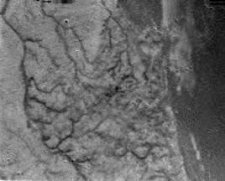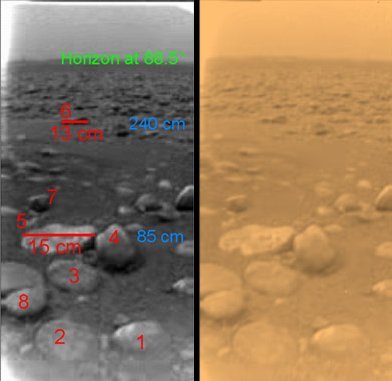|
The European Space
Agency's Huygens probe has landed on Saturn's giant moon Titan.
by Dr Tony Phillips
Congratulations, ESA!
The European Space Agency's (ESA's)
Huygens probe, carried to Saturn by the Cassini spacecraft, parachuted
to the surface of Saturn's giant moon Titan on Friday, Jan. 14th
2005, revealing finally what lies beneath Titan's thick orange clouds.
First images released by the ESA depict
sinuous drainage channels leading to an apparent shoreline. What's
draining? Possibly liquid methane. The orange landscape around the
Huygens landing site is littered with little rocks, rounded and
smooth like river-rocks on Earth. One of the images seems to show
tendrils of ground fog made not of water but perhaps ethane or methane.
It's all a bit familiar, yet at the
same time utterly alien. Researchers are elated.

ESA
From
an altitude of 16 km, Huygens photographed these drainage
channels leading to a shoreline.
|
Because Titan has a thick atmosphere,
able to carry sound waves, the moon is a noisy place. Microphones
onboard Huygens recorded the sound of wind rushing by the probe
as it descended. The ESA has released about one minute's worth of
the recording; it's a sample of what a traveler
riding with Huygens would have heard during the descent: click
here to listen.
Huygens was designed to float in case
it landed in a river or lake - but it didn't. After descending by
parachute for two and a half hours, the saucer-shaped probe hit
solid ground at a speed of 4.5 meters per second (10 mph), experiencing
a brief jolting deceleration of 15 Gs. Huygens survived the impact
and continued transmitting data for more than one hour after landing.
Among the measurements sent back to
Earth were air temperature, pressure, composition and wind speed
sampled at points ranging from the top of Titan's atmosphere to
the ground.

ESA
Small
"rocks," possibly made of water ice, at the Huygens
landing site. Evidence of erosion at the base of these objects
suggests fluvial activity. The right panel shows, approximately,
the true color of the scene.
|
The temperature of the landing site
itself was minus 291 degrees F. A "penetrometer" on the bottom of
the probe poked into the ground. The soil, it found, has the consistency
of wet sand or clay and is covered by a thin crust ... of something.
Scientists are still analyzing all this data.

ESA
A 360o
panoramic view of the terrain around Huygens' landing site.
Scientists speculate that the white streaks are a ground
'fog' of methane or ethane vapour.
|
There are enough photos, sounds and
other measurements to keep researchers busy for years. The data
released so far are preliminary, just a fraction of the total. Stay
tuned for more....
Author's Note: Cassini-Huygens
is a joint mission of NASA, ESA and the Italian Space Agency. ESA's
Huygens probe was carried to Saturn's orbit aboard Cassini, and
sent on its way to Titan on Dec. 24th, 2004. Cassini continues to
orbit Saturn on a four-year prime mission to study the planet, its
rings, moons and magnetosphere.
Want to know more?
Well, you can also read...
Plus I have put together
a Special Fact File Section with Trivia
all about Saturn
|
